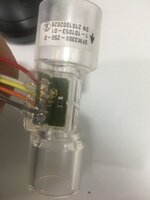zuirgham
Junior Member level 3
I'm designing a circuit for a digital flow meter. This is the part being used(SFM3300-D). The Sensor is being designed to be used with ventilator externally.
according to datasheet, It says using I2C communication, wire length should not be more than 30cm. But as we know, the patient tube is itself of minimum 2metrs in length.
I want to read the sensor data inside the device, which is Approx 2metrs away from the sensor. How do i do it? Any ideas on how to proceed? please do share.
Datasheet is attached for reference.
according to datasheet, It says using I2C communication, wire length should not be more than 30cm. But as we know, the patient tube is itself of minimum 2metrs in length.
I want to read the sensor data inside the device, which is Approx 2metrs away from the sensor. How do i do it? Any ideas on how to proceed? please do share.
Datasheet is attached for reference.
